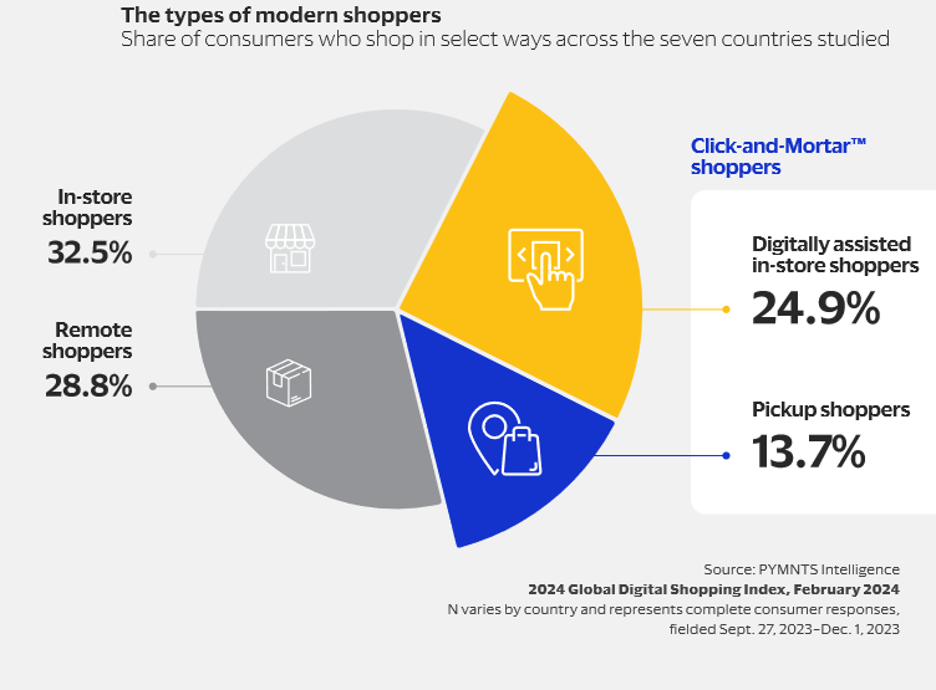European Retailers Awake to the Click-and-Mortar™ Shoppers

Last week, Intersport Deutschland, Germany’s largest sports retailer, announced plans to open 100 new retail storefronts across the country over the next six years, bringing the total number of shops it will eventually operate to 500.
CEO Alexander von Preen told the Financial Times he’s “very optimistic” about the rebound of brick-and-mortar outlets he’s seen in recent years and believes that by combining more physical stores with online sales, it will drive an omnichannel strategy.
The CEO is far from alone in believing the future of retail could hinge on giving shoppers physical and digital shopping options. As PYMNTS Intelligence reported last month, two other globally-recognized retailers are following similar paths.
These efforts might be designed to capitalize on a growing retail trend PYMNTS Intelligence first identified in its “2024 Global Digital Shopping Index,” a report commissioned by Visa Acceptance Solutions, which is based on historical data and survey findings from nearly 14,000 consumers and 3,512 merchants operating in seven countries.

The report uncovered the emergence of a new breed of consumers who relish both online and in-store shopping and leverage both to maximize their purchasing outcomes. These Click-and-Mortar™ shoppers typically find the items they want online and then make in-store appearances to finalize their purchases while cruising the aisles in search of other bargains. PYMNTS Intelligence determined Click-and-Mortar™ shoppers are now the fastest growing consumer segment on the planet, accounting for about 40% of shoppers worldwide.
As the accompanying graphic illustrates, Click-and-Mortar™ shoppers aren’t confined to old school shopping mindsets that relegate activities to either an “in-store” or “remote” experiences. Rather, they expect a seamless experience across both channels.
In other words, they are looking for convenience and consistency across all retail touchpoints and the share of consumers now embracing the Click-and-Mortar™ methodology has increased by a combined 38% across Brazil, the United Kingdom and the U.S. since 2020, which helps explain the resurgence in brick-and-mortar shopping von Preen alluded to in his interview.
In fact, PYMNTS Intelligence found that the use of digital-only retail channels has dropped 24% since 2020 in the U.S., U.K. and Brazil. And, as of 2024, just 29% of consumers across all countries covered in the report use online channels exclusively, down from a high of 34% in 2020. Additionally, the report found digital features now function as magnets, drawing consumers into storefronts. Conversely, online stores are now expected to replicate in-store experiences, complete with detailed product information, free shipping and digital try-ons.
Not surprisingly, this hybrid approach to shopping resonates mostly with younger, tech-savvy Generation Z and millennial consumers.
What may be surprising is the news that developed markets are behind the curve in catering to Click-and-Mortar™ shoppers. PYMNTS Intelligence found emerging markets such as Saudi Arabia or the United Arab Emirates are doing a better job of keeping pace with them. A reason? It’s easier to modernize shopping technology while it’s taking root, compared to the heavy lifting merchants in the U.S. and U.K. face when overhauling their legacy business models.
Merchants in developed markets might be lagging, but those intent on succeeding appear eager to evolve. As Von Breen told the Financial Times, “People want to touch the products before they buy them, and they are keen to get good advice.”

